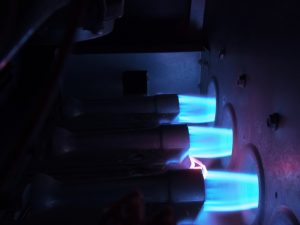 During fall, we stress the importance of our customers having maintenance for their gas furnaces. Maintenance takes care of many important steps to ensure the best performance from a furnace, but the most important benefit of maintenance is ensuring a furnace works safely.
During fall, we stress the importance of our customers having maintenance for their gas furnaces. Maintenance takes care of many important steps to ensure the best performance from a furnace, but the most important benefit of maintenance is ensuring a furnace works safely.
Gas furnaces aren’t inherently dangerous unless they suffer from neglect. Furnace manufacturers design their products with several vital safety measures, and during maintenance, our technicians carefully check each of them. One of the key safety features in a gas furnace is the flame sensor. Today we’ll give you the basics of what you need to know about this essential part of your furnace and how it protects you.
The Job of the Flame Sensor
When a gas furnace turns on to start a heating cycle, it allows natural gas flows to the burners. The electronic ignition system creates a spark or heats up a filament to ignite the gas, and the burners will continue to generate flames and heat until the furnace’s control board signals the end of the heating cycle and shuts the gas valve to stop the flow of gas to the burners.
Now suppose something went wrong with the furnace’s ignition system. That creates a safety concern because it means gas flowing from the burners won’t ignite and will instead start building up in the combustion chamber. Unburned gas is potentially dangerous, and delayed ignition can also cause an explosion of all this built-up gas. The furnace needs a way to tell if the ignition system has failed to light the burners, and this is the job of the flame sensor.
The flame sensor is an electronic device that detects heat from the burners. When the burners ignite as normal, the flame sensor generates an electric current it sends to the control board. If the control board doesn’t receive the electric current, it shuts off gas flow and ends the heating cycle.
If your furnace keeps shutting down when you request heat, it may be due to the flame sensor. Don’t try to overcome this problem: if the flame sensor is shutting down the furnace, it’s likely because something is wrong with the ignition system. You’ll need professionals to investigate the furnace and see what needs to be fixed.
Notes on Older Furnaces
You may have a gas furnace that uses a standing pilot light rather than an electronic ignition system. (We recommend having a furnace this old replaced, by the way.) In this case, a device called the thermocouple monitors if the pilot light is burning or not. If it isn’t, the thermocouple will close the valve to the gas line. The operation is similar to a flame sensor, but not as reliable.
Maintenance Keeps the Flame Sensor Working
Over time, a flame sensor can pick up dust, dirt, and carbon, which restrict it from working properly. This can lead to the furnace shutting off unexpectedly, or it can cause the furnace to operate unsafely. During maintenance, our technicians always check the flame sensor to ensure it can do its job. We’ll clean it or replace it as necessary to ensure your furnace continues to run safely. Our furnace repair in Mason, OH will see you have a hazard-free, comfortable winter.
Call Bartels Heating & Cooling “For a Comfortable Way of Life”! We have 24-hour emergency service available.
